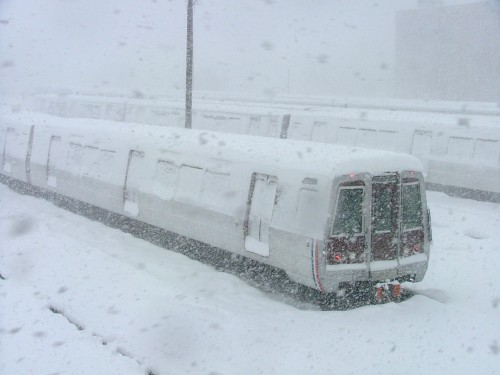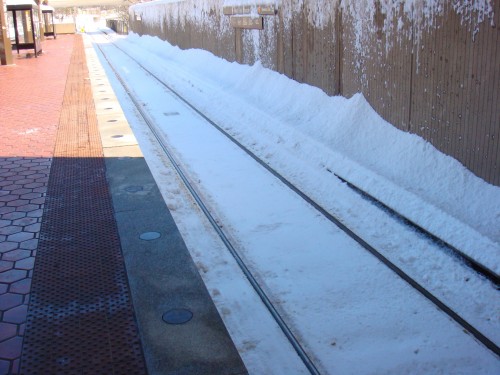Snow. You remember it, surely? Anywhere between two and four feet over the last week. It crippled our roads and sidewalks, and it’s left several small mountains in most of our neighborhoods. I’m sure you aren’t surprised that it also crippled Metro.
The bus system has to rely on local municipalities to clear snow from the roads. Many snow emergency routes were cleared fairly quickly, but the conditions on secondary streets varied wildly, leaving many buses running on altered routes, even today.
The subway system was also hard hit. Above ground service had to be shut down, and only fully came back online on Friday afternoon. By that point, the Federal government had reopened to one of the worst commutes (by car or by rail) that I’ve seen in 22 years here. So what happened and why, and what should Metro be doing differently in a storm?
Metro’s biggest challenge is keeping the electrified third rail clear of snow and ice. Once we have around 8″ of snow on the ground, Metro stops service for fear of damaging equipment on the undercarriage of the trains, as well as fear of the snowpack damaging the third rail. Metro uses heavy equipment as well as trains with deicing equipment to clear above ground tracks. It’s a slow process, and we saw from the weekend storm that it took Metro three days to clear the tracks.
Metro employees also had problems getting to the stations, with some supervisors having to drive SUVs to pick up employees from their homes. If you can’t get your staff and contractors there, it’s hard to clear the snow and make some headway.
As a smart man smart woman said to me, how could we have expected Metro to be ready on Friday, when it took them three days to dig out of the weekend storm? Indeed, expectations were too high for last week, knowing what we knew. But were they too high in general? What should Metro be able to deal with?
I believe Metro should be able to deal with the aftermath of huge snowfalls in the area without the crippling slowdown underground, and a quick recovery above ground. Unfortunately, that takes money, and the usual argument is that we don’t get enough snow in the area to spend that money on snow fighting equipment.
The problem I have with that line of thinking, though, is the eye-popping numbers which OPM estimates for lost productivity. One hundred million dollars in lost productivity per day is a rather large sum of money. And while I’m loathe to take that number at face value, it is clear that the impact on the Federal (not to mention local) budget is non-trivial. Perhaps the Federal and local governments can come up with some cash to help Metro purchase and prepare for larger snow storms. (Yeah, I know — unlikely.)
Metro’s current line item for snow fighting is $2.5 million. That’s not a lot of money, and includes everything from salt and deicer to contractors and equipment. We’re told by Metro staff that the numbers for last week’s storm are being calculated and due out later this week. We’ll be sure to share those numbers with you when we have them.
What’s reasonable? How much should the government spend to shore up snow fighting? What level should Metro be expected to operate at, in a town where average snowfall is about 15″ a season? Sound off with your expectations and experiences below.


One question: If Metro were to get the funds to purchase heavy snow removal equipment from the tracks/third rail, would the majority of these funds be a one time purchase? If this equipment were not used very often, would it/should it last a while?
Is it possible to hide/protect excess trains in tunnels just before a major storm? Are they already doing this?
Ahem, it was the smart man’s wife manning the @welovedc account that day. ;)
@Tiffany, my apologies! I thought Tom and I had that conversation, but then couldn’t find it in Twitter. I’ll update the post!
@Jan: They already put trains in the tunnels when they can. Unfortunately, this contributes to the unusably slow conditions we had on Wednesday, where trains were often sharing one track because the other track had parked trains on them.
As for the equipment question, they should last a long time. Some of our snowier cities run snow plows on trains, as well as deicing equipment. Because of that, I believe Chicago only has four diesel snow clearing trains.
What is the possiblity of leveraging equipment and purchases. For example Amtrak and Metro purchasing and sharing equipment and workers. WMATA and jurisdictional governments sharing resources. I think what’s most frustrating is that boundaries even if they intersect are not crossed by the various entities. In unprecendented emergencies there needs to be a standing MOU with some commonsense thrown in.
the point you raise about the bus system make your final question somewhat moot:
If the local jurisdictions can not clear the roads and sidewalks fast enough, people would not be able or perhaps even willing to walk or drive to and from metro stations.
We would have to have a regional solution for additional equipment acquisitions to be worth it.
@Deanwoodenizen: Amtrak doesn’t operate any 3rd-rail-based equipment. Their snow-removal requirements are much simpler — simply putting a plow on the front of a locomotive often suffices.
In other words, it wasn’t entirely surprising that they were able to get back up and running much more quickly then Metro were able to.
Amen about the absurd problems below-ground
The issues we have had recently are honestly….flabergasting, imo
Can we PLEASE have a major upgrade on our transportation. The fact that we have a top 5 MOST used subway system in America and it remains absurdly dysfunctional is ridiculous.